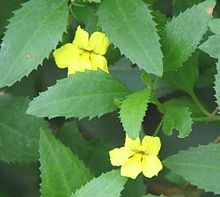Goodenia
| Goodenia | |
|---|---|

| |
| Goodenia ovata | |
| Scientific classification | |
| Kingdom: | Plantae |
| Clade: | Tracheophytes |
| Clade: | Angiosperms |
| Clade: | Eudicots |
| Clade: | Asterids |
| Order: | Asterales |
| Family: | Goodeniaceae |
| Genus: | Goodenia Sm.[1] |
| Species | |
|
About 200; See List of Goodenia species | |
| Synonyms[2] | |
|
List
| |
Goodenia is a genus of about two hundred species of flowering plants in the family Goodeniaceae. Plants in this genus are herbs or shrubs, mostly endemic to Australia. The leaves are variably-shaped, the flowers arranged in small groups, with three or five sepals, the corolla bilaterally symmetrical and either fan-shaped with two "lips" or tube-shaped. The petals are usually yellow to white, the stamens free from each other and the fruit a capsule.[3][4][5]
Taxonomy
The genus Goodenia was first formally described in 1793 by James Edward Smith in his book A Specimen of the Botany of New Holland and the first species he described was G. ramosissima,[6][7] now known as Scaevola ramosissima.[8] The name Goodenia honours Bishop of Carlisle Samuel Goodenough, a member of the Linnean Society of London at the time.[3][7]
Species list
Distribution
Most species of Goodenia are endemic to Australia but G. konigsbergeri is endemic to Southeast Asia.[9] G. armstrongiana,[10] G. purpurascens[11] and G. pumilio[12] extend to New Guinea and G. pilosa extends to the Philippines.[13] Species of Goodenia are found in all states, including in arid and semi-arid areas.[14]
References
- ^ "Goodenia". Australian Plant Census. Retrieved 30 December 2020.
- ^ "Goodenia Sm. | Plants of the World Online | Kew Science". Plants of the World Online. Retrieved 2024-03-04.
- ^ a b Carolin, Roger C. "Goodenia". Australian Biological Resources Study, Department of Agriculture, Water and the Environment: Canberra. Retrieved 14 December 2020.
- ^ Jeanes, Jeff A. "Goodenia". Royal Botanic Gardens Victoria. Retrieved 14 December 2020.
- ^ Carolin, Roger C. "Goodenia". Royal Botanic Garden Sydney. Retrieved 14 December 2020.
- ^ "Goodenia". APNI. Retrieved 14 December 2020.
- ^ a b Smith, James Edward (1793). A Specimen of the Botany of New Holland. London: J. Sowerby. pp. 15–16. Retrieved 14 December 2020.
- ^ "Scaevola ramosissima". Australian Plant Census. Retrieved 4 March 2024.
- ^ "Goodenia konigsbergeri". Plants of the World Online. Retrieved 14 December 2020.
- ^ "Goodenia armstroniana". Plants of the World Online. Retrieved 14 December 2020.
- ^ "Goodenia purpurascens". Plants of the World Online. Retrieved 14 December 2020.
- ^ "Goodenia pumilio". Plants of the World Online. Retrieved 14 December 2020.
- ^ "Goodenia pilosa". Plants of the World Online. Retrieved 14 December 2020.
- ^ "Goodenia". FloraBase. Western Australian Government Department of Biodiversity, Conservation and Attractions.